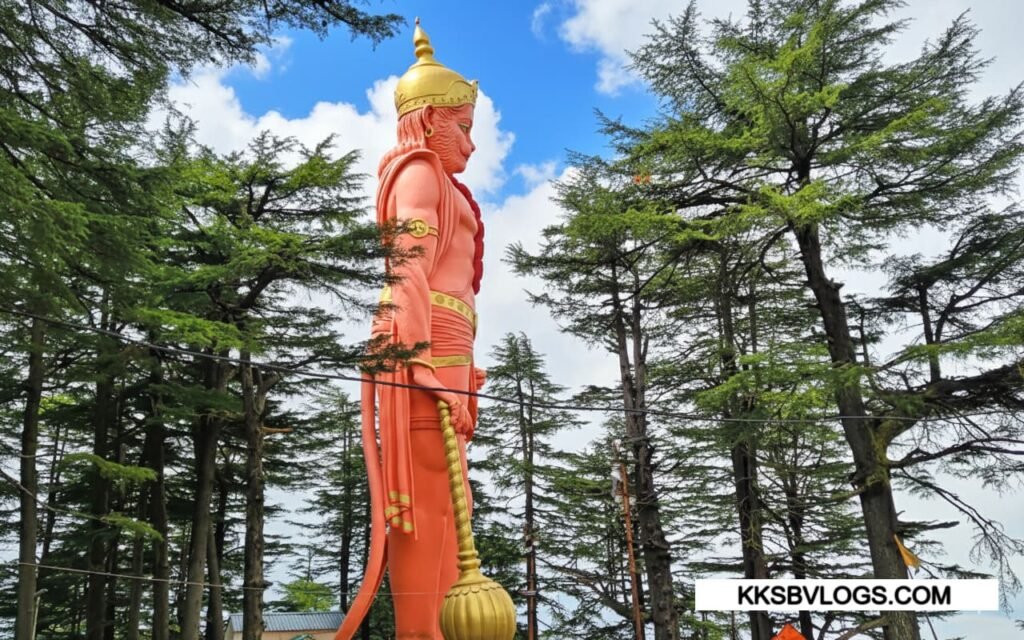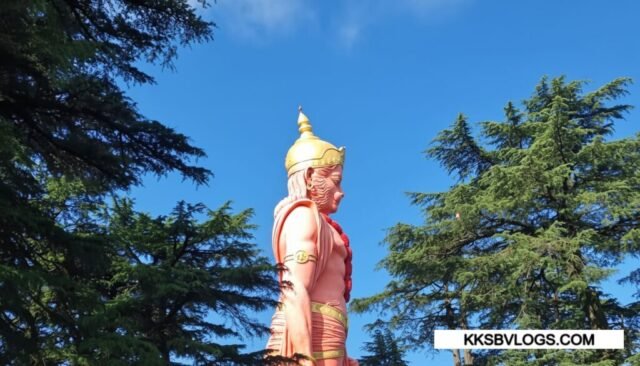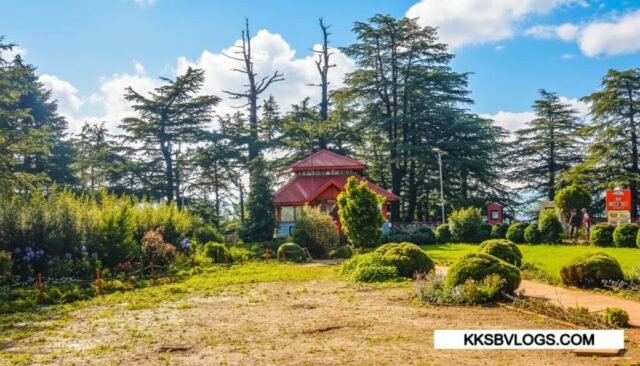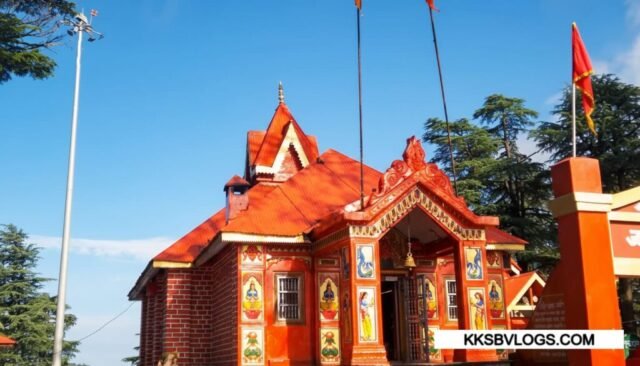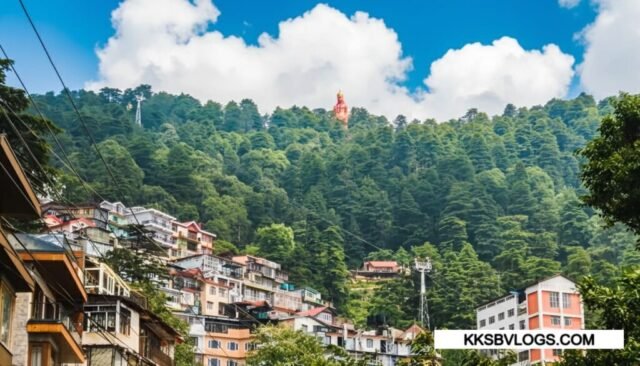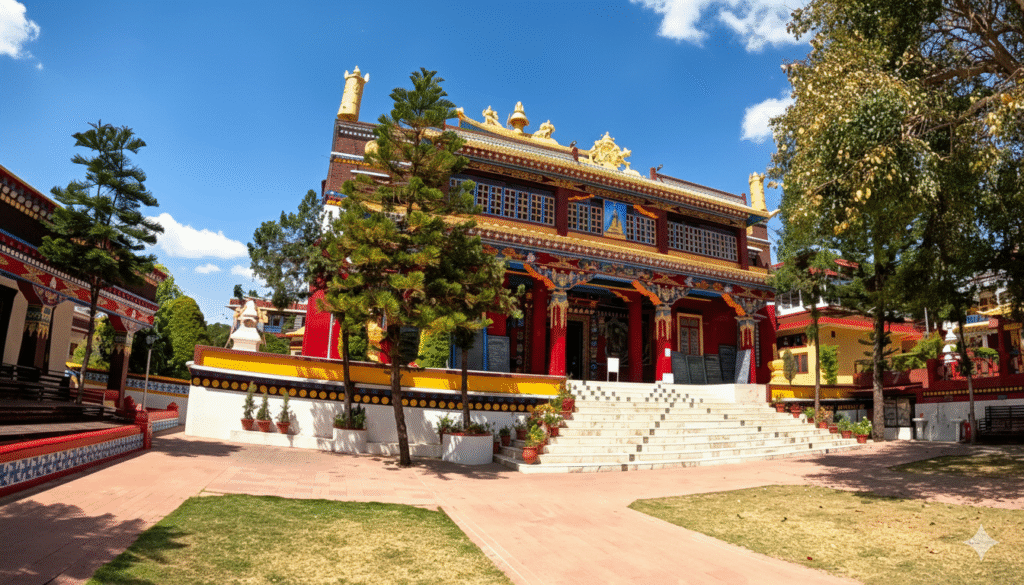1) Introduction
Shimla, the “Queen of Hills” of Himachal Pradesh, is famous across the world for its natural beauty, colonial-era architecture, and pleasant climate. From British times till today, this hill station attracts thousands of travelers every season. Snow-capped mountains, pine forests, and winding roads make the city a dream destination.
But the true heart of Shimla does not only beat in its natural beauty or heritage buildings—it also pulses in its deep spiritual essence.
The biggest representative of this spiritual charm is Jakhu Hanuman Temple Shimla – Complete Travel Guide with History, Timings, Ropeway Details and Visiting Tips, considered Shimla’s oldest, most visited, and highest temple. Standing at an altitude of 8,054 ft (2,455 meters) on Jakhu Hill—the city’s highest point—this temple makes you feel as if you are standing in a divine world in the middle of the Himalayas.
Dedicated to Lord Hanuman, Jakhu Temple is world-famous for its mythological background and the 108-feet tall Hanuman statue. This giant red-colored idol is so high that you can see it from anywhere in Shimla—be it Mall Road, the Ridge, Christ Church, or any other corner of the city.
It is not just a landmark but a spiritual symbol that fills the surroundings with divine energy.
The panoramic view from the temple is unforgettable—Shimla valley, the Shivalik ranges, and far-stretching snow-clad Himalayan peaks can all be captured in a single glance.
During early morning or sunset, the golden horizon from this spot stays in your memory forever.
In this blog, we will explore in detail:
Jakhu Temple’s history and legends connected to the Ramayana,
Construction and significance of the 108-feet Hanuman statue,
Temple architecture and spiritual importance,
Festivals that make this temple lively,
Trek and ropeway guide to reach the temple,
Complete visitor information like timings, entry details, and best time to visit,
And nearby attractions that make your trip even more memorable.
This is a complete travel guide that will not only make your Shimla trip easier but also give you a unique experience with a spiritual touch.
2) History & Legends of Jakhu Temple
2.1 Ramayana Connection
The story of Jakhu Temple is deeply linked to the epic Ramayana.
During the battle of Ram and Ravan, when Lakshman became unconscious, Vaidya Sushena sent Lord Hanuman to the Himalayas to bring the Sanjeevani Booti. On the way, Hanuman rested on this hill—today known as Jakhu Hill.
It is believed that when he rested, his immense weight flattened the top of the hill.
Because of this, this place is considered sacred with the divine presence of Lord Hanuman
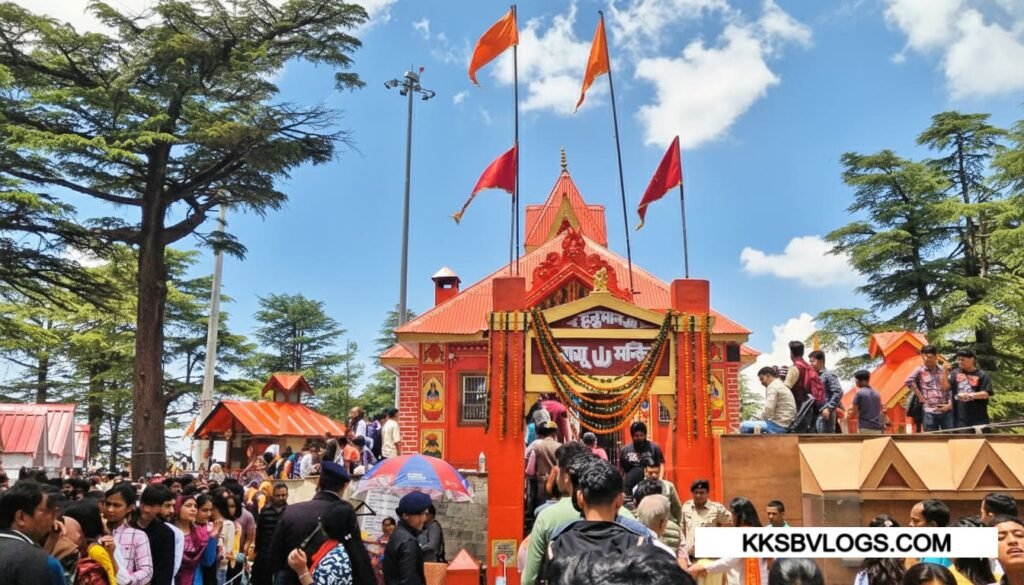
2.2 Temple Origin
After Lord Hanuman’s stay, sages established a Hanuman temple here.
The name “Jakhu” is derived from “Yaksha,” which represents celestial beings.
2.3 Legends of Monkeys
Another interesting aspect of Jakhu Temple is its monkey population.
Locals believe these monkeys are descendants of Hanuman’s vanar sena (monkey army).
Every devotee is believed to receive their blessings, though visitors are advised to handle their belongings—such as spectacles and food—carefully.
3) Architecture & Spiritual Significance
3.1 Temple Design:
Jakhu Temple’s architecture is simple, yet its spiritual aura is extremely strong.
Painted in red and white, the temple houses a sacred Hanuman idol, worshipped daily with aarti, devotional bhajans, and the chanting of Hanuman Chalisa.
3.2 The Hanuman Statue
In 2010, a 108-feet tall Hanuman statue was installed here.
It is taller than Christ the Redeemer in Rio, Brazil and has become an iconic landmark of Shimla.
Height: 108 ft – a sacred number in Hinduism (108 beads in a mala, 108 mantras).
Cost: Around ₹10 crore.
Visibility: Clearly visible from all over Shimla—the Ridge, Mall Road, Christ Church, and surrounding valleys.
Night View: At night, when illuminated, the statue looks even more divine.
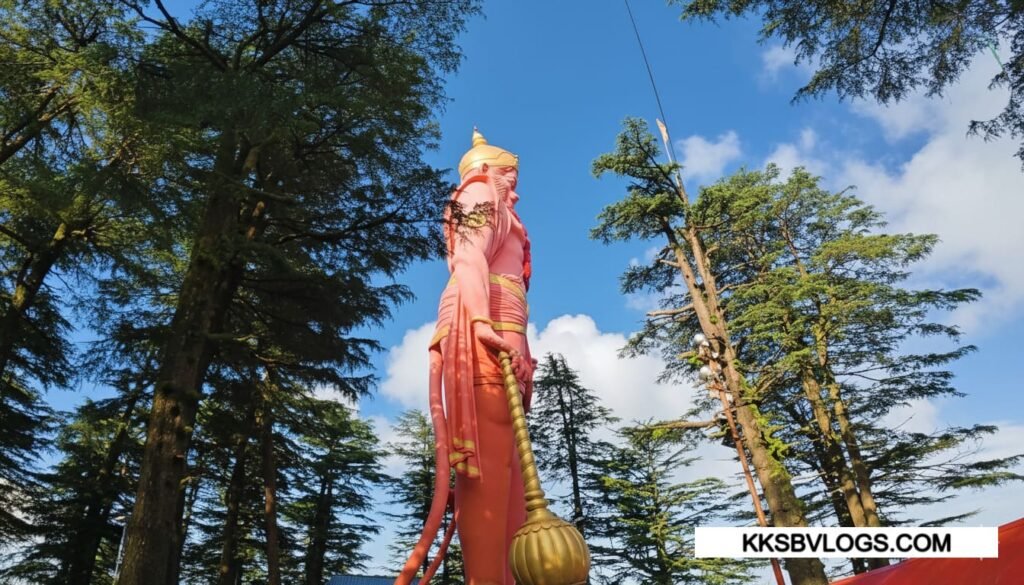
3.3 Spiritual Importance
Jakhu Temple is considered a siddh peeth—a sacred seat where devotees’ wishes are fulfilled.
Visitors chant Hanuman Chalisa and verses from the Ramayana here.
Located at Shimla’s highest point, the temple beautifully merges nature and devotion.
4) Festivals & Celebrations at Jakhu Temple
4.1 Dussehra Festival
Jakhu Temple is the main center of Dussehra celebrations in Shimla.
Every year, a grand fair is organized here, attracting thousands of devotees.
Special Hanuman puja, cultural programs, and fairs are arranged.
The area comes alive with stalls, local Himachali food, and devotional music.
Locals believe that Hanuman’s presence is especially powerful on Dussehra, making this day a perfect blend of spirituality and culture.
4.2 Hanuman Jayanti
Hanuman Jayanti is the biggest religious festival at Jakhu Temple.
On this day, devotees gather for collective recitation of Hanuman Chalisa.
The temple is decorated with flowers and lights.
Special arrangements are made for both the ropeway and the trekking path due to heavy crowds.
4.3 Ram Navami & Navratri
Special rituals are also performed on Ram Navami.
During Navratri, the temple is filled with devotion and spiritual energy.
✨ During all these festivals, the 108-feet Hanuman statue glows with lights, visible from every corner of Shimla.
5) Things to See at Jakhu Temple
108-Feet Hanuman Statue – The most iconic landmark of Shimla, inaugurated in 2010. Visible from every corner of the city and a true symbol of devotion.
Main Sanctum – The inner sanctum houses the sacred idol of Lord Hanuman. Devotees offer sindoor, flowers, and prasad here, creating a deeply divine atmosphere.
Panoramic Views – From Jakhu Hill, one can see the Shivalik ranges, Mall Road, and distant snow-covered peaks. In winter, when everything is covered in snow, the view becomes even more magical.
Monkey Troops – Thousands of monkeys live around the temple and are believed to be descendants of Hanuman’s vanar sena. Visitors should be careful with food items and sunglasses.
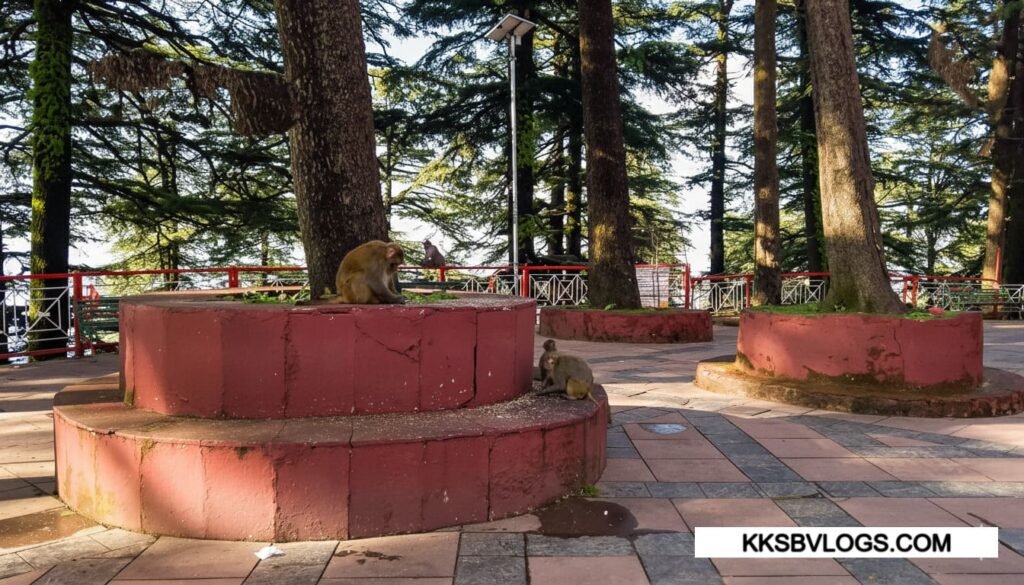
Jakhu Ropeway Ride – The ropeway from the Ridge to the temple provides a scenic aerial view of Shimla and is an adventurous way to reach the temple.
Forest Trail – The trek passes through dense deodar forests, offering a beautiful mix of nature and spirituality unique to Jakhu.
6) How to Reach Jakhu Temple – Trek & Ropeway Guide
📍 Location: Jakhu Hill, about 2 km from the Ridge, Shimla
6.1 By Road
A steep and narrow road (~2 km) leads from the Ridge to Jakhu Hill.
Local taxis are available, but during the peak tourist season, traffic can be heavy.
You can drive a car directly up to the temple gate, but most visitors prefer trekking or taking the ropeway for a more scenic and peaceful experience.
6.2 By Trek (Jakhu Temple Trek)
Starting Point: Near Christ Church at the Ridge
Distance: ~2 km
Duration: 30–45 minutes
Difficulty: Easy to moderate (the climb is steep but the path is well-paved)
Highlights:
During the trek, you walk through dense deodar forests, hear birdsong, and feel the natural silence of Shimla, creating a calm and spiritual atmosphere.
Pro Tip: Start early in the morning when the weather is cooler and monkeys are less active.
6.3 By Ropeway (Jakhu Ropeway)
Start Point: Ridge, near the parking area
Duration: 5–6 minutes
Charges: ~₹250 one way / ₹450 round trip per person
Best For: Families with elderly people or small children, and anyone who wants to avoid trekking
Experience:
The ropeway gives a bird’s-eye view of Shimla’s rooftops and valleys, making the short ride feel cinematic and adventurous.
6.4 By Train & Air
Shimla Railway Station: ~5 km from the Ridge; connected via the famous Kalka–Shimla Toy Train.
Shimla Jubarhatti Airport: ~28 km away.
Chandigarh Airport: ~129 km away, offering better flight connectivity.

7) Best Time to Visit Jakhu Temple
Best Time to Visit Jakhu Temple
Jakhu Temple can be visited throughout the year, but each season has its own unique charm.
March – June (Summer)
- Best time for trekking.
- Pleasant weather (15–25 °C) and clear skies make the valley and mountain views spectacular.
July – September (Monsoon)
- Surrounding greenery is at its peak.
- After rain, the deodar forests and the temple look fresh and lush.
- However, the trek can be slippery—carry a raincoat and shoes with good grip.
October – February (Winter)
- The most magical season.
- The temple and the 108-feet Hanuman statue are often covered in snow, giving them a divine glow.
- Temperatures can drop to 0 °C or lower, so warm clothes are essential.
✨ Pro Tip:
- Morning (before 10 am) is the best time to visit—crowds are thinner and monkeys are less active.
- During major festivals like Hanuman Jayanti and Dussehra, the temple atmosphere becomes even more grand and spiritual.
8) Visitor Information
Visitor Information (Hinglish)
- Timings: 7:00 AM – 8:00 PM (Ropeway 9:00 AM – 7:00 PM)
- Entry Fee: Free (darshan ke liye koi charge nahi hai)
- Ropeway Charges: Approx. ₹250 one way / ₹450 round trip per person
Facilities:
- Drinking water points
- Prasad shops aur small food stalls
- Seating benches aur rest spots
- Paid parking near Ridge (ropeway base)
Dress Code:
- Comfortable aur decent clothing (trek ke liye sports shoes best hain)
Safety Tips:
- Apne spectacles aur food items secure rakhein – monkeys snatch kar sakte hain.
- Elderly visitors ke liye trek tough ho sakta hai, unke liye ropeway ya taxi best option hai.
- Photography allowed hai, lekin temple sanctum ke andar flash use avoid karein.
Time Required:
- Around 1.5 – 2 hours (including trek/ropeway + darshan + photography)
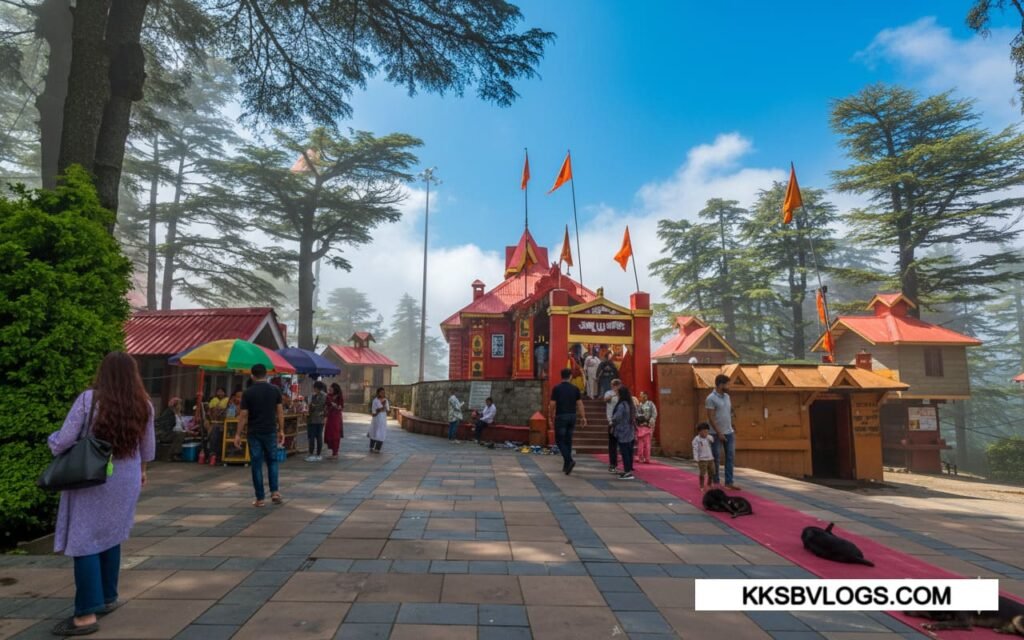
9) Our Experience
Our trips to Shimla are always special, and the most spiritual and adventurous destination is Jakhu Temple, also popularly known as Jakhu Hanuman Temple. We visit this place again and again, but honestly, I personally love the walk from Ridge to the temple the most. Passing through the trail surrounded by tall deodar trees, listening to the sweet chirping of birds, and feeling the cool mountain breeze makes every step refreshing. This trekking experience is not just a physical journey; it feels like a natural meditation.
Sometimes I also use the Jakhu Ropeway, which is another amazing experience. In just a few minutes, you get a breathtaking aerial view of Shimla—the colonial rooftops and snow-capped Himalayan peaks look truly cinematic from above. The smooth ropeway glide and cool breeze create a thrill that stays in memory forever.
However, you must stay alert because monkeys at Jakhu Temple are everywhere. They are quite smart and love to grab visitors’ belongings like food packets, spectacles, or phones. In fact, one of our friends had a real incident—a monkey grabbed his phone and ran away! The phone was only returned after we offered some food. So whenever you visit Jakhu Hanuman Temple, make sure to keep your mobile and valuables safe.
Reaching the top and seeing the 108-feet tall Hanuman statue for the first time is always an awe-inspiring moment. This grand red-colored statue dominates Shimla’s skyline and is visible from every corner of the city—whether you’re standing on the Mall Road, Christ Church, or Ridge. Inside the temple, the soothing sound of bells and chants of Hanuman Chalisa brings deep peace to the heart. Outside, the panoramic view of Shimla valley, Shivalik ranges, and the distant snow-covered Himalayan peaks feels like a living postcard.
For us, Jakhu Temple offers the perfect blend of devotion, natural beauty, and adventure—an experience every traveler should have when visiting Shimla. Whether you are a spiritual seeker, a photography lover, or a nature enthusiast, Jakhu Hanuman Temple in Shimla is truly a must-visit destination.
8) Nearby Attractions to Explore
1. The Ridge & Christ Church (~2 km)
The cultural hub of Shimla, perfect for evening strolls and soaking in colonial charm.
This open space hosts almost every major festival and event.
Right here stands Christ Church—the second-oldest church in North India—famous for its Neo-Gothic architecture and beautiful stained glass windows.
2. Mall Road (~2 km)
The true heartbeat of Shimla, Mall Road is a shopping and leisure paradise.
It is lined with heritage buildings, cafés, restaurants, and shops selling local handicrafts.
A walk on Mall Road after visiting Jakhu Temple is the perfect combination of spirituality and leisure.
3. Kufri (~13 km)
For adventure lovers and snow seekers, Kufri is a must-visit destination.
Horse riding, skiing, the Himalayan Nature Park, and its snow-covered slopes make Kufri a year-round tourist magnet.
4. Sankat Mochan Hanuman Temple (~15 km)
Located on the outskirts of Shimla, this temple is also dedicated to Lord Hanuman.
Compared to Jakhu, it remains less crowded, making it a peaceful and calm spot.
For spiritual seekers looking for a quiet retreat, this is a perfect alternative.
5. Tara Devi Temple:
Tara Devi Temple(~24 km)Situated on a hilltop just outside Shimla, Tara Devi Temple is dedicated to Goddess Tara.
From here, you get a 360° panoramic view of the Shivalik hills and surrounding valleys.
It is also a photographer’s paradise with breathtaking natural vistas.
Jakhu temple Location, Photos & Videos
YouTube Video:Coming soon on – KKSB Vlogs
Instagram Updates: Stay connected with us for reels and updates– @official_kksb
Jakhu Hanuman Temple Photos
Jakhu Temple Google Map Location
❓ FAQs about Jakhu Hanuman Temple Shimla
Where is Jakhu Temple located?
Jakhu Temple is located on Jakhu Hill (2,455 m), the highest point of Shimla.
It is only 2 km from the Ridge, and can be easily reached by trek, taxi, or ropeway.
Because of its central location, it is part of every tourist itinerary.
Why is Jakhu Temple famous?
The temple is world-famous for its ancient Hanuman shrine and the 108-feet tall Hanuman statue, visible from every corner of Shimla.
The panoramic views of valleys and Himalayan peaks make it even more attractive.
How much is the Jakhu Ropeway ticket?
The Jakhu Ropeway runs directly from the Ridge to the temple.
Ticket charges are about ₹250 (one way) and ₹450 (round trip).
The ride takes only 5–6 minutes and offers a breathtaking aerial view of Shimla town and the surrounding valleys.
What is the best time to visit Jakhu Temple?
March–June: Best for pleasant weather and trekking.
October–February: Magical time to see the snow-capped Hanuman statue.
Pro Tip: Visit in the morning (before 10 am) for a peaceful experience and fewer monkeys.
Is the Jakhu Temple trek difficult?
The trek from the Ridge to the temple is about 2 km and takes 30–45 minutes.
The path is steep but well-paved, making it an easy-to-moderate trek.
For elderly people and small children, ropeway or taxi is a more comfortable option.
Are the monkeys at Jakhu Temple safe?
Monkeys are always present around the temple and can be mischievous.
They sometimes snatch food items or sunglasses.
Visitors should keep their belongings secure, and renting a bamboo stick for protection is a smart tip.
What nearby places are worth visiting?
Close to Jakhu Temple, you can easily include The Ridge & Christ Church, Mall Road, Kufri, Sankat Mochan Hanuman Temple, and Tara Devi Temple in a one or two-day Shimla itinerary.

